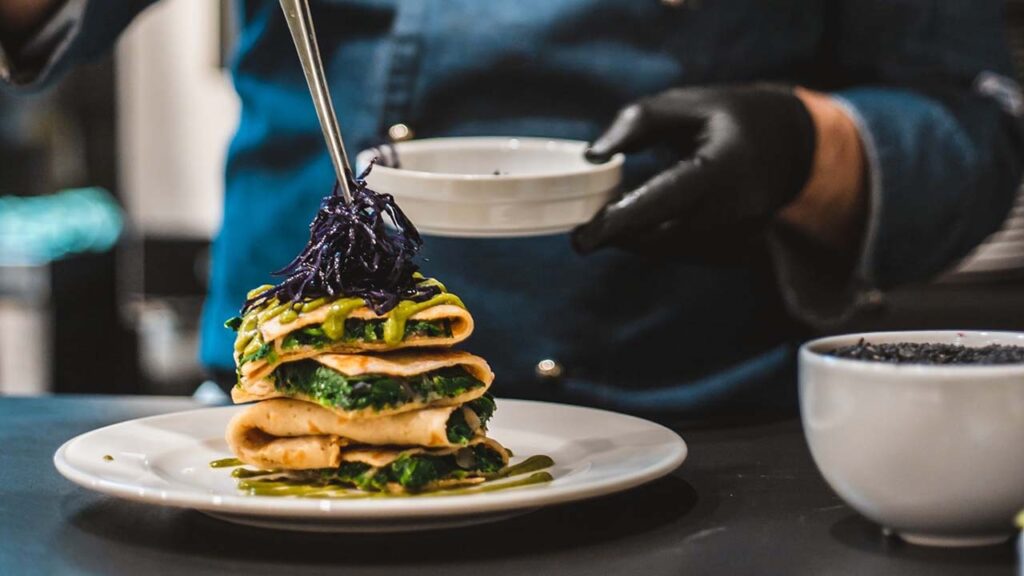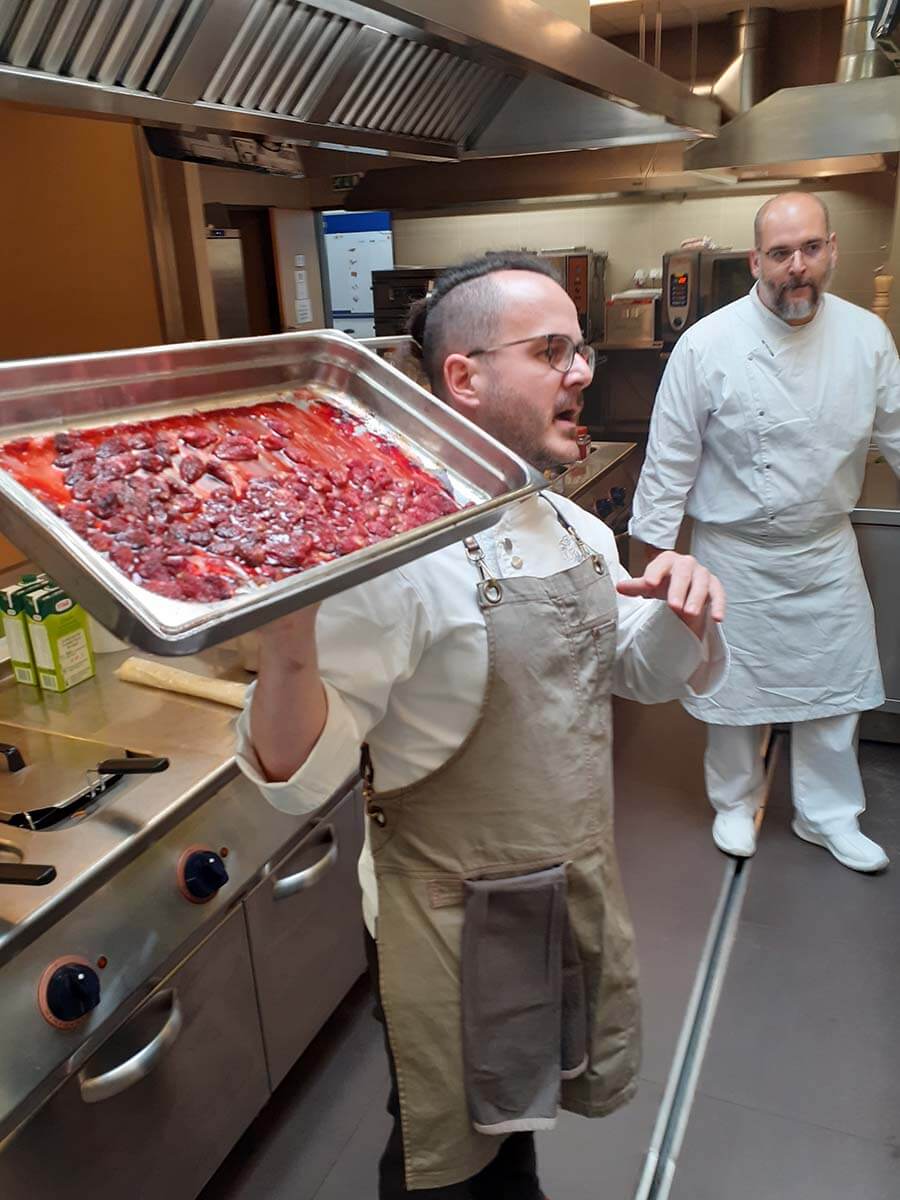
“Every restaurant should have a plant-based option” – Interview with Gergely Zsolnay
Gergely Zsolnay is an executive chef, horticultural engineer and qualified nutritionist. Executive chef at The Planteen in Budapest and former executive chef and manager of Flow Specialty Coffee Bar & Bistro on Andrássy út. He has been on a plant-based diet for 7 years. He is committed to spreading the benefits of plant-based food, helping restaurants to develop and economize plant-based options or whole plant offerings through consulting and cooking courses, training and lectures.
We spoke to him on the occasion of his masterclass series on plant-based pasta for restaurants at the METRO Gastronomy Academy.
Q: What motivated you to take the plant-based masterclass?
A: I started my career in traditional gastronomy, I was not vegan at that time. When I switched, it was a very difficult situation because I saw that the gap between traditional gastronomy and the colleagues involved in it, as well as between the representatives of plant-based gastronomy that were there at that time, was very wide. When I switched, plant-based nutrition and the vegan mindset became important. There is a helpfulness and a sense of mission to develop plant-based gastronomy. Not to eat because we have to, but because it gives us a special experience, while eating healthier and having a positive impact on our environment and sustainability. Cooking classes are a good way to get information to people, so educate them a little. I was very keen to see the quality of this sector of gastronomy develop and to bring the two groups a little closer together, those who represent traditional and those who represent plant-based gastronomy. I saw that there were tensions and I really believed, I believe, that it is possible to bring people closer together.

So, after 7 years, I can say that we have achieved quite a lot and they are much more open to it. Not only consumers, but also our catering colleagues. Now not with an offensive attitude, but with interest, questions, openness, trying things themselves. It is also a very big sign that now people from a very wide range of gastronomy participants are coming to this type of training. Not only amateurs and interested people, but also colleagues, participants from catering, bistros, higher class a’la carte restaurants. They feel there is a need for this, they are open to it and are looking for opportunities where they can learn in this direction.
There will also be training in a month’s time and the mix of people interested is very mixed. For example, a Michelin-starred a la carte restaurant has also applied, so there are some quite surprising things happening now. A number of top restaurants in Budapest and in the countryside are introducing plant-based menus periodically or as part of their permanent offer, which is a very good thing.
Q: Some of the people on the course have said that they don’t really know if they will be able to apply what they have learned in the places where they work. But they are very interested in plant-based food preparation.
A: When we made the sweet “cottage cheese”, there was a group of two people who said that they didn’t really like it, it was too acidic, not good. Then, when all the dishes were ready and we sat down to eat at 3pm, two of them came up to me and said that they hadn’t thought of it, but the flavours were really good together and that the dish was great in one piece. Then we talked about how it could be applied in their kitchen. So I find that what we have learned goes on in people’s heads. Rounding it off, I found that it was particularly well received.
Q: In the introduction before the cookout, you explained why it is important for all restaurants to start offering a vegan option and for caterers to take steps in this direction.
A: Yes, they make it easier to get people to change step by step, the impact on consumers increases exponentially.
What needs to be understood is that consumers are not the enemy of themselves or of the caterers, but have important underlying intentions, whether it is animal welfare, health or even climate impact. I think that caterers, as I said five or six years ago, all hotels and all restaurants should pay attention to including this type of food in their offer, otherwise they will be at a serious disadvantage in the market in 10 years’ time. I still hold that now, they have 4 years to go. It is now up to the canteens to ensure that there are days, if not every day, when people can eat meat-free. This could have a very positive effect not only on the service providers, but also on the health and attitudes of consumers and, last but not least, it would also have major benefits at state level, both economically and in terms of public health protection.
Obviously, this is unthinkable without education, so it is necessary to provide information to the public at the same time as changing or expanding the offer. I am not saying that this is necessarily the role of caterers, but they can help this process. They presumably do not have the time or capacity, or perhaps the training or knowledge, to educate. But just as Ervin Nagy (NÉGYOSZ) has carried out many valuable projects in recent years, perhaps a similar material could be produced which can be communicated by caterers to guests and consumers, or to retailers. This could be a big step forward.

Q: At the last training, one of the participating chefs told me that they don’t work with such unusual, strange ingredients as millet. This is interesting, because in the past they used to use not only millet, but also chickpeas, for example, and now it is as if vegans had brought it to Hungary as a novelty from a distant planet.
A: It was a very interesting process. Obviously, it is a very verbose statement, but we are very much concerned with our ancient cuisine, and it is absolutely certain that these types of crops, grains, pseudo-grains played a role in their diet, and they were present in the Carpathian Basin. There were/are also wild-gathered varieties and cultivated varieties. There is a widespread ‘particular’ historical approach, which does not always correspond to reality, and which has a practice that affects humans. Food itself is an absolute identity-forming and identity-maintaining element. Interestingly, for example, healthy eating means ten million different things to ten million people. Obviously, many things from material opportunities to knowledge to physical limitations will control it. This is very important because if I say that I think health rests on this pillar, the other person will not be looking for awareness, but for the facts that support their truth. So if he thinks that part of nutrition and healthy eating is dairy and meat and plant-based is not healthy, then he will simply take those foods and those ideas and look for those that support that.
This is why the process is time-consuming, as eating meat with meat is a defining part of Hungarian identity. They made it that way. It wasn’t always like this, in fact! It is not just about economic prosperity, it has simply become part of being Hungarian. It is a dowry of the last 50-100 years. I talk a lot to my grandmothers, who kept animals and had a butcher’s shop in the countryside, and I ask them how much meat they ate as children. They said, son, we ate meat once a week or once every two weeks.
But it would have been possible, but it was just a different custom then, because we were much more attached or connected to our old roots. Nowadays, if you go to a rural village, it is unthinkable for people to eat a plant-based diet. While we have a lot of food, simple dishes, stews, soups, finishing dishes, which is basically meatless. The same is true for eggs. It’s not true that egg noodles are the good one. But in those households where the family was industrious, there were eggs, and when there were eggs, they certainly added eggs to the dishes. But equally, when we didn’t have eggs, or when we had fewer eggs, they were omitted. You can say that about a thousand things, for example meat and vegetable-based meatballs, eggs were just a fortification. (Of course, nowadays their technological importance is huge, but they are not irreplaceable.) Western gastronomy has taken this as its basis, and it has become the culture, for example, if you look at French cuisine, it’s all about butter, cream and eggs.
It’s really the root source and that’s why you have to be extremely patient, humble and go forward respecting other people’s ideas. I think it takes decades to make that change. It has to start, but it is not going to change the habits of a society of nations overnight. I think that the Hungarian people need to go back to their roots. It is not certain that everyone has to be a vegan, but it is certain that a significant percentage of society would eat well on a basically plant-based diet.
Q: Let’s return to the topic that it would be nice if restaurants had at least one or two options. What would you say to those restaurants where the vegetable option is at most salted tofu with rice, and at a high price because we asked for extras? What can you do to make it simple and economical for them, sustainable from a kitchen point of view, and to keep the guest happy?
A: As a practising chef, I can argue both sides. The cooks are spinning 12-14 hours a day, as per normal routine. It’s very difficult for them to handle a guest coming in with extra needs. Obviously there is a human element to it, but I have also often found that they just can’t cope with it all. The consumer also needs to be educated about this, so that he knows when, where and what he can ask for. The other part is that we must also educate our colleagues, and this distance between the two sides must be reduced and bridged. The restaurant also needs to understand that it needs to improve in this area, but the guest also needs to understand how a restaurant works.
We see that today there are a lot of guests with special needs. Gluten-free, dairy-free, egg-free are quite widespread needs. In the same way, the demand for vegetarian or vegan or plant-based dishes is growing rapidly. Restaurants can avoid this difficulty by including at least 2 plant-based dishes on the menu. I would recommend at least one soup or starter and at least one main course. The menu should be designed so that there are one or two main courses that can be requested with optional toppings (main items); one vegetable, one meat or one cheese. If the caterer does this much, it takes a hell of a load off his shoulders. It gives the customer a choice and the kitchen doesn’t have to improvise. In addition, in six months, you can track what your clientele wants and needs.
It is worth knowing that it is not vegans who eat these foods most of the time. There are also very often people with mixed diets who prefer a lighter diet, and this would be a good option for them too. In the plant-based kitchens I’ve worked in, typically 80 to 90 percent of the guests have been mixed diets. A restaurant can take the organisational, financial and traceability burden off its shoulders if it can add a dish to the menu that a special needs guest can choose. If they mix it up so that it is gluten-free, dairy-free, egg-free and vegan, they can target more customers with a single dish. If you functionally add to this dish that you can also have this or that meat or cheese for an extra charge, then you can satisfy the needs of all guests.
Whether they can do that on their own or whether they need advice, education or a collaboration is something that has to be judged on an individual basis. When I go to hotels and restaurants for advice and menu planning, my experience is that there are as many houses as there are customs and possibilities and as many gifts. There is no single one-size-fits-all solution, but it is possible to find a tailor-made solution for every restaurant and every catering establishment and hotel that can easily be adapted to their circumstances.